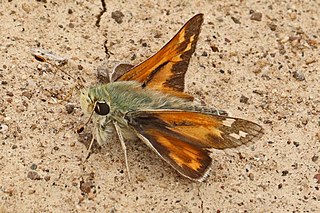Related Research Articles

Ulmus elongataL. K. Fu & C. S. Ding , also known as the long raceme elm in the US, is a deciduous tree endemic to broadleaf forests in the eastern provinces of China.
Scytalopteryx is a monotypic moth genus belonging to the subfamily Drepaninae first described by Ritsema in 1889. It contains the species Scytalopteryx elongata, described by Snellen in 1889, which is found in Sundaland.

Hesperia juba, the Juba skipper, Yuba skipper, or jagged-border skipper, is a butterfly of the family Hesperiidae. It is found in North America from British Columbia, south to southern California, east to Montana, Wyoming, Colorado, and north-western New Mexico.
Neomicropteryx bifurca is a species of moth belonging to the family Micropterigidae. It was described by Syuti Issiki in 1953. It is known from Japan.
Neomicropteryx cornuta is a species of moth belonging to the family Micropterigidae. It was described by Syuti Issiki in 1953. It is known from Japan.
Neomicropteryx kazusana is a species of moth belonging to the family Micropterigidae. It was described by Hashimoto in 1992. It is known from Japan (Honshu).
Neomicropteryx matsumurana is a species of moth belonging to the family Micropterigidae. It was described by Syuti Issiki in 1931. It is known from Japan.
Neomicropteryx nipponensis is a species of moth belonging to the family Micropterigidae. It was described by Syuti Issiki in 1931. It is known from Japan.
Issikiomartyria nudata is a species of moth belonging to the family Micropterigidae. It was described by Syuti Issiki in 1953. It is known from Japan.
Neomicropteryx kiwana is a species of moth belonging to the family Micropterigidae. It was described by Hashimoto in 2006 and is known from Japan.
Neomicropteryx redacta is a species of moth belonging to the family Micropterigidae. It was described by Hashimoto in 2006 and is known from Japan.

Micropterigoidea is the superfamily of "mandibulate archaic moths", all placed in the single family Micropterigidae, containing currently about twenty living genera. They are considered the most primitive extant lineage of lepidoptera. The name comes from the Greek for mikros, little and pterux, a wing. The fossil record of the group goes back to the Middle-Late Jurassic with the earliest known species being Auliepterix from the Karabastau Formation in Kazakhstan.
Brenthia elongata is a moth of the family Choreutidae. It is known from Puerto Rico and the Virgin Islands.
Brassica elongata, the elongated mustard or long-stalked rape, is a species of the mustard plant that is native to parts of Central Europe, Eastern Europe, the Balkan Peninsula, the Caucasus, Morocco and parts of Central Asia. Through plant invasion this species has become naturalized in many other parts of the world. Some of these naturalized regions include South Africa, North Western Europe, Australia and North America. Given the wide range of climate and ecological conditions of these regions, B. elongata has been able to disrupt the ecosystems of their native plant habitats and has been label as an invasive species in many of its naturalized zones. In North America, this species is often found as a roadside weed in the southwestern states, particularly in the state of Nevada. Studies allude that the Cruciferae might have migrated through the Bering land bridge from what is now Central Asia. Commonly known as the long-stalked rape or as langtraubiger Kohl in German, this species is a close cousin to Brassica napus (rapeseed) and a secondary genetic relative to B. oleracea (kale). As a close genetic species of the rapeseed, the long-stalked rape has one of the highest counts of accumulated polyunsaturated linoleic and linolenic acid. Both compounds are heavily used to manufacture vegetable oils. Brassica elongata has the propagative potential of turning into a horticultural product from what is currently a noxious weed.
Anarsia elongata is a moth of the family Gelechiidae. It was described by Kyu-Tek Park in 1995. It is found in Taiwan and Thailand.
Epipomponia elongata is a moth in the family Epipyropidae. It was described by Karl Jordan in 1928. It is found in South America.

Cyrtopone is an extinct genus of ants in the formicid subfamily Ponerinae described from fossils found in Europe. There are four described species placed into the genus, Cyrtopone curiosa, Cyrtopone elongata, Cyrtopone microcephala, and Cyrtopone striata. Cyrtopone is one several Lutetian Ponerinae genera.

Serruria elongata or long-stalk spiderhead is a plant belonging to the protea family. It is an erect, hairless shrublet of 1–1½ m (3½–5 ft) high with densely set, alternate, finely divided leaves lower down the plant, with needle-like segments. On top of an up to 30 cm (12 in) long inflorescence stalk are several, loosely arranged heads of pin-like, densely silvery-haired flower buds, each of which opens with four curled, magenta pink corolla lobes. The species is endemic to the southern Western Cape province of South Africa. It flowers during the southern hemisphere winter and early spring, between June and September.

Lovellona elongata is a species of sea snail, a marine gastropod mollusk in the family Mitromorphidae.
Vrydagzynea elongata, commonly known as the tonsil orchid, is a species of orchid that is native to New Guinea, the Maluku Islands and far north Queensland. It has between four and seven dark green, egg-shaped leaves and a large number of white resupinate flowers which barely open.
References
- ↑ Beccaloni, G.; Scoble, M.; Kitching, I.; Simonsen, T.; Robinson, G.; Pitkin, B.; Hine, A.; Lyal, C., eds. (2003). "Neomicropteryx elongata". The Global Lepidoptera Names Index . Natural History Museum . Retrieved April 21, 2018.
- ↑ Japanese Moths
| This article on a moth of the family Micropterigidae is a stub. You can help Wikipedia by expanding it. |